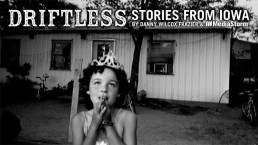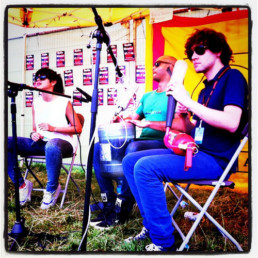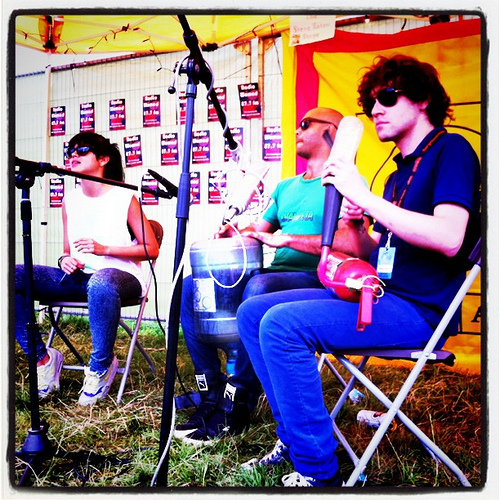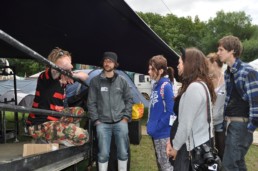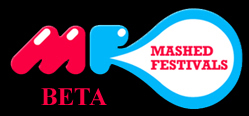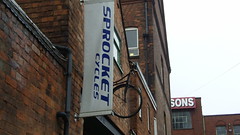Insight into Brian Storm's MediaStorm
This week at Newsroom360 we were visited by Brian Storm.
Storm cut his teeth in MSNBC and Corbis before starting his own production company. MediaStorm works with journalists for a variety of news organisations, NGO's and charities. Its style is longer form, non-perishable, universal stories with high production values. Although the films have beginnings in beautifully composed photo-journalism it's the interplay between this and well rendered video composition which really give the stories an emotional impact and feeling of quality. Storm showed us "Harry and Helen" from Driftless as an example of this.
Borrowing from Hollywood
MediaStorm's films take conventions from cinema rather than a vérité news style, using atmospheric music and dropped introductions to heighten dramatic impact and put people at the centre of the story. Even the way that his videos are marketed using teasers or "preludes" which resemble Hollywood trailers.
Revenue Models
These promos are often used to raise funds through the Kickstarter crowd-funding site. For A Darkness Visible, $10,000 was raised privately in return for limited edition rewards. Even when making work for with clients Brian depends on his work's virality, allowing sharing on social media and embedding for dedicated blogs helps build momentum. Book-ending this content with adverts is a significant revenue driver, although Storm concedes that CPM (cost for thousand impressions) for adverts in the US is higher than here. Interestingly longer stories retain the viewer if the film is interesting enough, Storm gave his own sites stats as an example: the average time on site is 16 minutes. Storm also recommended treading carefully and choosing advertisers and other streams such as sponsorship affiliation should also be explored.
Slow vs Fast
Brian's message is you can be two things with online video: funny or quality. Journalists tend to be better at the latter. We have to consider how longer-tail in-depth production fits into the daily or weekly news cycle. Although, as a passing shot Storm also shared a three team collaboration of writer, photographer and film maker who managed to turn around a stirring documentary in a week.
Radio Womad gets Mashed
Continuing my experiments with mobile journalism, this weekend I embedded myself at Womad Festival with the onsite radio team.
I used last year's project with Shambala as a template for my activity. The live blog in particular carried through similar elements, including a mobile friendly blog and distribution techniques - but there were differences, as I'll explain.
Wi-fi Network
Uploading material on a 3G network was a real problem at Shambala, and as I've mentioned before this made mobile journalism at last year's festival very tricky. Thankfully this was not an issue at Womad, which was down to the excellent site wide public WiFi provided by Etherlive. I spoke to the MD Chris Green and he told me in total they shifted 1TB (terabyte) of internet traffic this weekend - which I got really excited about, my wife didn't.
Kit and Tech
Last year I had an Android HTC Tattoo, Flips, dictaphones, SLRs and a Flash mic. 2011, I had an iPhone 4. My dependency on additional bits of tech to give comprehensive multimedia coverage was less needed. It also meant that I approached it differently. Video was shot and uploaded directly to YouTube from my phone and photos were initially shared on Instagram first. I still had my SLR but Instagram tended to be my first port of call. I would like to find a web app that makes it more useable and interactive online - not least an app that allows search and the opportunity to search for tagged photos and install slideshows. Further investigation is needed into the Instagram Realtime API and these interfaces. At Womad Festival, all my photos were run through Flickr with video and slideshows broadcast on YouTube.
Radio Womad
Being involved with the Radio Womad staff meant audio was a priority, features and "Secret Sessions" (essentially backstage acoustic performances), were broadcast on the radio and enhanced for the internet. Unfortunately a big question mark still hangs over whether we have the right to publish this material. I hope we can as the Secret Sessions were fantastic - particularly the session with Bomba Estereo whose improvised instruments included a fire extinguisher and a water bottle.
Radio Womad's backstage gazebo was a perfect platform to let the artists do what they want in their way and I'm delighted there's a digital archive of this ready to be shared with a global audience. I think it would be great for Radio Womad to have a shareable archive of the sessions.
Whilst the video was by no means professional it would offer music fans a glimpse into the unique, unplugged gigs. Also many of the labels and artists liaisons want to see the material so it seems a shame not to share with the wider public. Surely sharing this material would be good for everyone?
Staff
My experience with Shambala was essentially to manage a team who in turn managed our Press Gang (teenagers we trained to capture footage on our behalf). For Radio Womad it was about adding value, enhancing social media and putting a multimedia twist on the audio material. Although the Radio Womad team were largely impressed by what I achieved it was difficult to wrangle multimedia stuff (which they were taking personally) off them, in the end I managed to steal memory cards and copy clips from the station server to create my material.
The benefit of the team at Shambala is that we saw the festival through younger eyes. I'd love to work with Radio Womad again but I wonder whether next time the project might benefit from repositioning itself with the main website, which could also help sidestep any reproduction permission issues.
Moving on
Whilst for the moment the secret sessions may remain secret it seems to me that this is a direction that I'd been thinking about with Village Underground "In The Cab" performances. I know recording and sharing the performance of the artist Marques Toliver secured him several UK gigs because the material was so shareable and exposure extended beyond the 300 people who turned up to see him live. This is an area which I will no-doubt return to when I undertake some more work with Village Underground later this month. As for the festival itself and working with Radio Womad, it was a hugely enjoyable experience and I would love the opportunity to do something next year.
I've collected everything together at the working blog, Facebook, and have hosted all material on the Mashed Festivals Soundcloud Flickr and YouTube Channels.
I would love to know what you think - or if you're interested in working with Mashed Festivals.
Proving Ourselves In A Field – Mashed Festivals At Shambala
Since October last year I’ve been researching and developing my idea of bringing Mobile Journalism to Music Festivals. As festival season kicked off the website started to take shape. With help from Caroline Beavon, a few early experiments in uploading and curating content took place at Glastonbury, Sudoeste in Portugal and Off The Cuff in Birmingham but the main target was a full blown operation at Shambala Festival which took place on August Bank Holiday weekend 2010.
I’ve spent a lot of time developing the site and defining the brand over the summer, it’s still very much in development. In fact, one of the main advantages of working with Shambala was that they were open to new ideas and willing to help us develop, but naturally there was a degree of reciprocation with this relationship.
Shambala suggested Mashed Festivals (MF) offered media training to teenagers and taught them how to produce online content using mobile techniques. I wasn’t too keen to do this in the beginning as I wanted content on the MF site to be professionally captured from a team of journalists with different expertise. The best stuff for the site would be produced by my core team which would set the bench mark for the quality of the user generated content (UGC) - I was concerned the teenage training element would devalue this.
I couldn’t have been more wrong. With the cooperation of Shambala we sent out an invitation to all teen ticket members and cherry picked a small team of six girls and boys who were enthusiastic and talented to boot who became the MF Press Gang. Their final output which comprised 40 stories on the mobile optimised microsite is of such a high standard that I’m now moving away from the idea of curating unfocussed UGC altogether.
I still kept my professional core team who had a breadth of experience but were able to specialise and train in certain areas. I offered advice and assistance in photography, Juliet Spare advised on audio and Jon Kennard’s expertise lie in film and video. Caroline Beavon was in control of the process of collation and uploading.
Jon Kennard details his experience training for video with Hannah Lepper and Kyle Douglas here.
Both Iona Berry and Holly Game were studying photography at college. Iona brought her own camera and was pretty self-sufficient. We provided Holly with a camera and she needed a little more encouragement and guidance. I offered advice on what looked good online and stressed the importance of speed rather than spending days filtering and treating photos.
None of the teenagers had any experience in audio but wanted to learn so Juliet trained two members of the press gang. Josephine Gilbert learnt very quickly delivering perceptive interviews.
Piers Baker experimented with different media and with contributions from his girlfriend Phoebe and other members, delivered some excellent self contained packages.
Some of the best material came when the gang teamed up to combine skills. My favourite examples being the slideshows. Which included contributions from all the group.
My favourite experience was taking the Press Gang backstage for the first time, showing them how to gain access, secure interviews and find the person in charge! This resulted in a wealth of material and a superb interview.
I was very pleased the Press Gang didn’t just stick to one skill. Being competent in a few different fields is important for journalism overall these days and vital for Online Journalism.
Village Underground Residency
As mentioned in previous blogs I've been doing a consultancy placement at Village Underground. I spent Monday and Tuesday in residence and two very different events were covered. On Monday we had a gig featuring TV On The Radio’s Kyp Malone Rain Machine project, with Marques Toliver in support. On Tuesday I was able to catch the ‘get in’ for Collaborative Dance Experience’s debut production Out Of Time.
I took with me 2 Kodak Zi8s and a Flip, my Dictaphone and an SLR camera. I was very happy with the material I shot. My first catch was Marques Toliver performing In The Cab. We were able to grab him between soundchecks and take him to the drivers cab of one of the tube trains on the roof. After his interview he performed an exclusive song. I shot this on all three cameras but put a quick rush on YouTube.
http://www.youtube.com/watch?v=6xJxgFuL2SQ
More Audio Visual Mapping Possiblities
Following my audio map blog Woices contacted me and offered me the infospot for free for a year. You can download the iPhone app from here. I'd love to know how you get on with it. Hopefully they have plans to develop an Android version soon.
I was also talked through the early stages of Ruby and given a book on Rails by @budhhamagnet whilst at Ruby In The Pub. Although I know I've got a steep hill to climb I think I might be able to develop something even better.
In preparation for International Dance Festival frolics Chris Unitt has alerted me to the possibilities of playing around with augmented reality app Layar. Keep an eye and ear out for more developments...
In the mean time you may not have spotted the enhanced podcast, with pictures in iPod or iTunes or just a nice sound tour for everyone else. Download the enhanced podcast here. Or the normal MP3 here.
Why stay on the 'side?
Putting the Created In Birmingham shop in the Bullring in the centre of Birmingham means that we're proud of our art.
A bug bear I have about Birmingham is creativity occurs on the fringes of the city, and often this can make us appear self deprecating. It's almost as if were embarrassed by our artists so we push them to the outskirts. Don't get me wrong, I'm behind the redefined Eastside. In fact I wrote the brochure's main copy. But where I struggled was working out how to make art accessible and appealing in description, without appearing to trivialise or belittle 'the art.' A picture paints a thousand words, I just wanted people to visit Eastside and make up their own minds. Hopefully, many will this weekend.
The great thing about CiB shop's centrality is that people can check it out, with very little effort. If this shop was based in Digbeth, for example, they wouldn't have a fraction of the footfall. Take a look at this large and diverse mix of people in this 30 minute sample (recorded by me at 11am on a Thursday).
Okay, Pete Ashton in particular acknowledges it's "in a shopping centre" so there are a few pieces that might be too leftfield for this consumer-centric audience. But its strong centre-stage presence is great exposure for all artists adorning the walls and shelves. And intrinsically Created In Birmingham features independent artists creating original pieces.
Besides wouldn't it be great if when the City Of Culture judges get off the train and the first place they pop into is this shop?
Home Of Metal audio and mapping
I'm fascinated by the capabilities of Geolocation so I decided as part of my multimedia portfolio I'd play around with some audio which was recorded on a Home Of Metal tour, hosted by Chris Phipps in March 2009.
To Vimeo Or Not To Vimeo
For my first Multimedia Assignment I'm experimenting with video. But even putting out short chunked segments takes a while to edit, and even longer to upload. In my Production Lab work there's been a lot of discussion about which platform is better, Vimeo or YouTube. Certainly from a time perspective, YouTube is much quicker to upload. It took me a few hours to get three three-minute clips up last night. With Vimeo I had to leave the first clip overnight, the second took two hours this morning to upload, and I've given up on the third after it kept on dropping out.
The thing is I know Vimeo is generally considered the better platform, especially for aesthetically sensitive designers but it appears my allocation only allows me to upload on HD package a week. And besides YouTube now offers unlimited HD. For standard Vimeo there's a cap at 500Mb. Here's the two clips together, see if you can really spot the difference. For extra fun play them together.
Enhancing My Silver Skins Podcast
When I started producing my Silver Skins podcast, I was often asked whether I'd cleared the music copyright. My argument was far from comprehensive, usually involving an explanation that I always talk over the beginning and end of my tracks in traditional 'Radio 1 Top 40' style. I also mumbled that much of my music is new material which is benefiting from exposure to a niche 'older but still cool' audience.
Silver Skins is a receptacle for music that I am passionate about. The intention behind the podcast was to appeal to a generation who, like me, still loved music and refused to be knocked into any kind of middle-age music box. The passion part also has a lot linked to my ideas behind Blowback: this isn't cycnical aloof abstraction about music industry trends but genuinely wanting to play the best music I experience - and pass on that experience. I've had fans of the podcast contact me, claiming that since listening to the show, they have gone out and bought the album, or seen the musician live. I've recently discovered this opinion is shared by UK Podcasters Association and was backed up by The 2008 MCPS-PRS Podcast License.
For a while I've sided with Andrew Dubber's view on copyright, musicians should benefit from exposure rather than try and claw back the potential money they might have been lost. Nevertheless, in a world where people are illegally uploading and downloading entire movies or albums I very much doubt PRS would be interested in the one compressed track that I rabbit all over. But if the request does ever come, I will take it down.
In the mean time, I might be able to offer one further justification. I was inspired by Mixmag's excellent podcast which provides enhanced capabilities. The fact that you can click on an image if playing in iTunes, (or possibly even on iTouch or iPhone - yet to test) you could buy the track in full from the store.
With my Enhanced Silver Skins, these are all bitly short links, so I will be able to measure how many people click through to the store as a result of listening to my podcast. Hopefully my case will be strengthened by recent reports that paid for downloads have boosted music sales.
There are other enhanced treats aswell, so have fun downloading and let me know what you think of the tweaked podcast. At the moment I realise that this podcast is a bit Apple-centric so if you have any idea of how I can reproduce the same effect in PC and on other audio devices then please let me know.
You can download the enhanced Silver Skins 3 by right clicking here.
Or you can subscribe to the RSS via my archive site.
Sprocket Cycles
I went to Sprocket Cycles, off Allison St Digbeth where Gordon quick-fitted a new bike chain in 3 minutes.
I also grabbed a short audio interview with Gordon talked about cycling safety, National 'Bike' Service and just what is the correct kerb distance?
